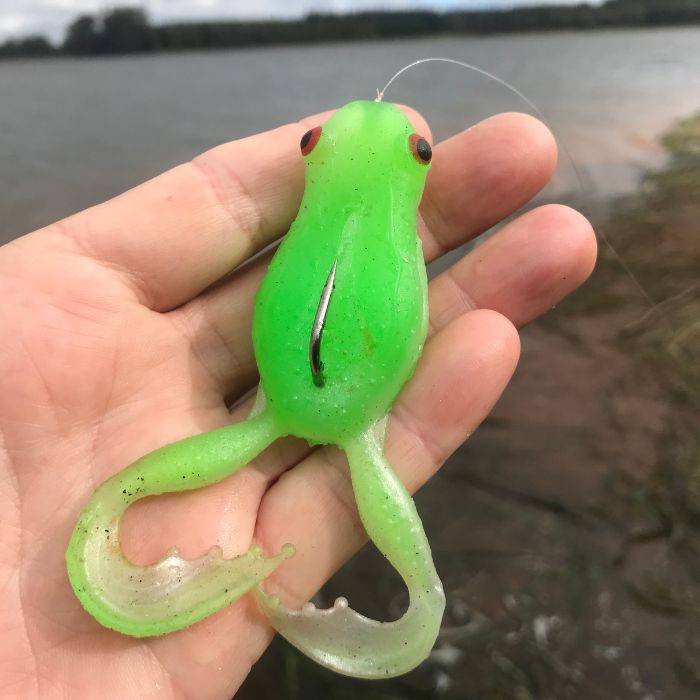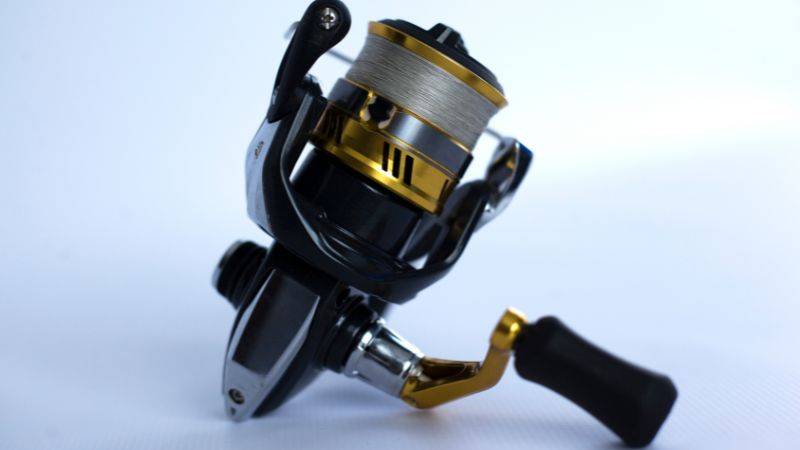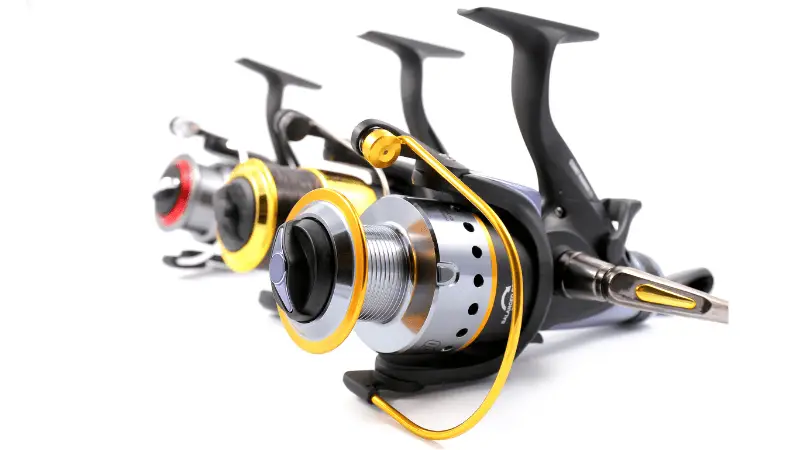Getting towed around by a fish in a kayak is crazy fun, but there can be a learning curve involved.
So if you are new to kayak fishing, here are 30 kayak fishing tips for beginners, or even a seasoned fisherfolk to make wetting a line easier from a canoe, or kayak.
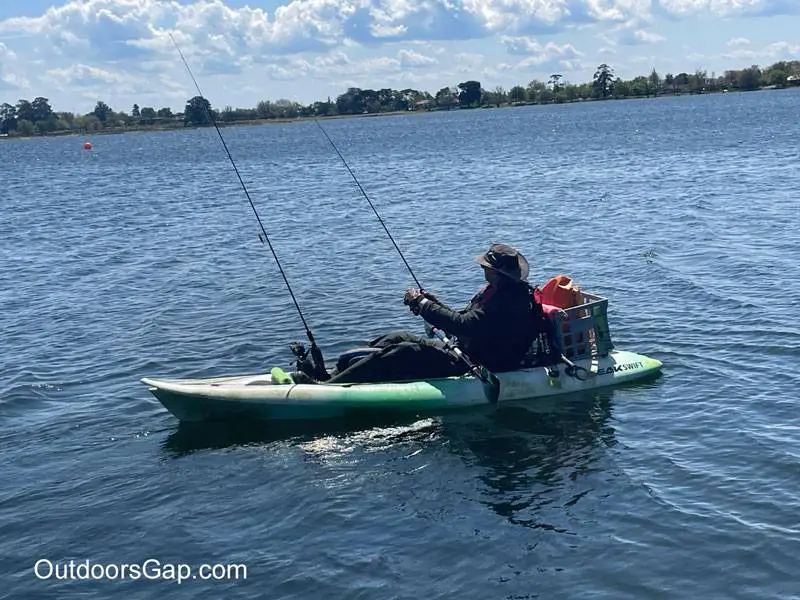
These tips and ideas cover both freshwater and saltwater kayak fishing and most of these tips cover categories like:
- Catch more fish
- Safety
- Comfort on the water
Kayak Fishing Tips And Tricks
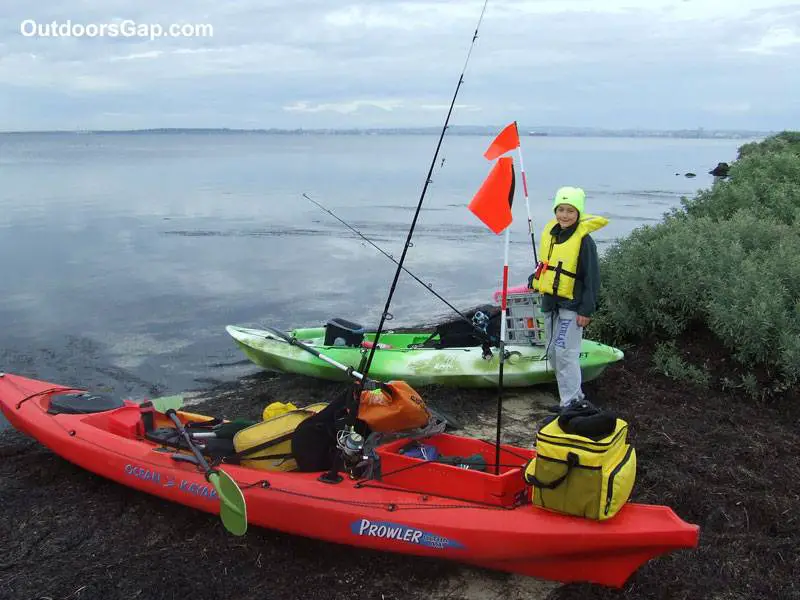
1. Secure Your Gear
It is painstaking to watch kayak fisherman capsize, or even just lose fishing gear like rods and tackle boxes overboard. So here are a few ideas.
One solution is to tether your gear with cordage. For some tools like your fishing tackle bag, or fishing line nippers, you can tether it with a short bit of cordage to the kayak.
Be careful the cordage isn’t too long or it can be a tangle hazard if you do capsize.
If you don’t like tethering items, tie floats with a short section of cordage to the item. You can get key ring floats for smaller items like fishing pliers or fish lip grips.
I use a short section of swimming pool noodle foam tethered to my Sage Fly rod when kayak fishing. It doesn’t get in the way of casting. (I would hate to see it go overboard and sink to the depths.)
Tether your paddle to your kayak. It might be embarrassing if your paddle floats away from your kayak and you are stuck in the middle of the lake.
Other ideas is to use foam/rubber tubing on items. I have some rubber tubing on the handle of my landing net which helps it float.
Place other items in the storage hatches, so it is secure if you capsize.
- Fish Around Features And Structure
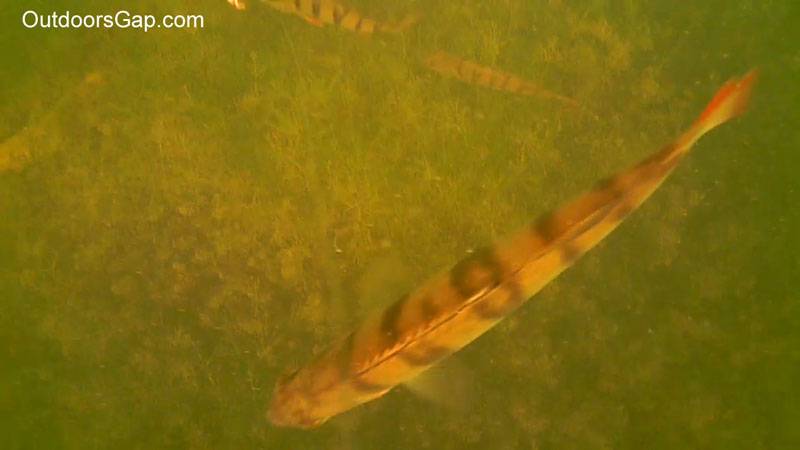
It doesn’t matter if you are fishing the Murray River for cod, Sydney for snapper, or fishing for trophy trout in Tasmania, one of the best kayak fishing tips, (or fishing tips in general) is to fish around structure and features like:
- Rock walls
- Reefs and Artificial reefs
- Channels
- Submerged timber
- Drop offs
- Inlets and outlets
- Weed beds
- Piers, jetties and pylons
- Depressions
- Newly flooded areas
- Points and bays
Structures and features can hold small baitfish and aquatic insects close to them, this means that bigger fish can also hang around structures and also get protection from bigger predators.
Shallow bays at dusk, dawn and night time can also be an effective place to fish as bigger fish come into feed looking for prey.
A depth sounder or fish finder on your kayak can help locate some of these structures and is handy.
For more tips and information, click on – Kayak Fishing Questions
Also visit – Kayak Fishing Tips
- Plan Your Trip
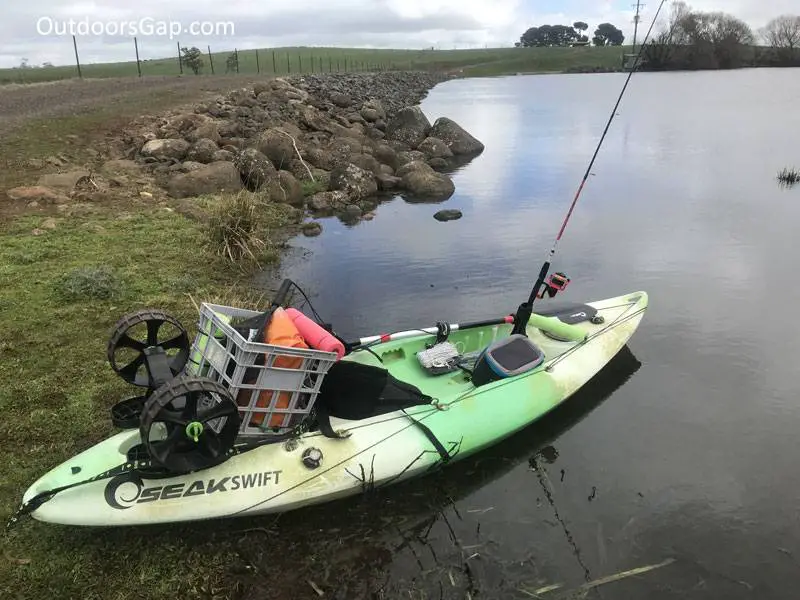
From finding spots to launch your kayak, to the actual fishing locations and spot, planning your trip can make it easier.
Google maps, tide times, local angler knowledge, fishing forums, fishing maps can help you get information and plan your trip more effectively. Do your homework and use these resources ahead of time to find some good locations and spots.
Use the local weather forecast to work in with your plan.
You might even have a back-up plan in case the weather isn’t as good as predicted, or the water way is too busy.
While your plan can change due to the conditions, planning the trip helps you get the most out of the fishing trip and hopefully on to more fish.
- Swimming Pool Noodles
Swimming pool noodles have a hundred uses when fishing or kayak fishing.
- Tether gear to them, so it floats if you capsize
- Wrap leaders, hooks and pre made fishing rigs around them
- Put it on your milk crate and make it buoyant
- Use as extra floatation in the hull of your kayak
- Cut small pieces off the noodle foam and use it if you forget your fishing bubble floats
- Use a small bit as a strike indicator
- Wrap anchor rope around a section for rope storage
- Use the foam noodle for padding
The uses for kayak fishing with a swimming pool noodles is limited by your imagination.
You can even use a swimming pool noodle to transport your rods tangle free in the back of your vehicle with them. For more information click on – How To Transport Your Fishing Rods Tangle Free. 7 DIY Ways
- Drift Fishing
Drift fishing can be an effective fishing strategy.
If you are fishing for flathead, in locations like Port Phillip Bay, or loch style fly fishing like at Lake Wendouree and the conditions are good, (not too windy) try just drifting slowly for fish. This way you can cover more ground and find potential hotspots.
Obviously be aware that if you drift for a kilometre, then you have to paddle back a kilometre. Be mindful that the weather can change and the wind can pick up.
A parachute sea drift anchor can take a bit to work to manage, but can slow your drift down.
Use the currents or tides to work in with your fishing plan.
If you are fishing saltwater or large open bays, be aware of the current or wind can make paddling back harder, or almost impossible in some locations or conditions.
- Know Your Limits
If you are new to kayak fishing (or a seasoned vet and need a reminder) know your limits on the water. That can mean don’t go too far from where you launched. In the wind it can be hard work if you are physically worn out paddling or the wind changes.
Australian waters can get rough and the wide variety of big lakes and sea fishing spots is endless, so it is easy to get carried away and try to fish everywhere. (The grass seems always greener fishing in another spot.)
Also for safety, know what conditions you can or cannot go out to fish in. Your kayak’s capabilities, your fitness levels and skill level may not be suited for the open sea, or for strong currents or rough windy waters.
For beginners, do short little fishing trips in good weather, until you get more confidence in your gear and skill levels.
- Use An Anchor Trolley
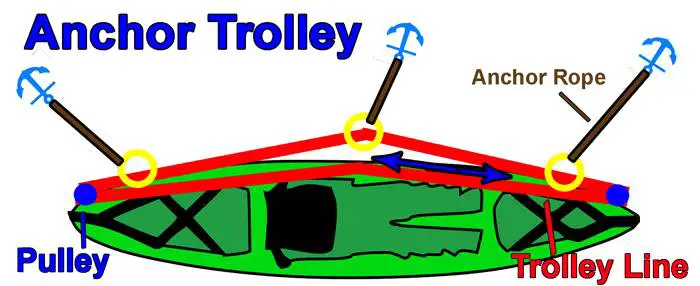
An anchor trolley helps you set the tether angle direction from your anchor rope to your fishing kayak. (Not to be confused with a kayak trolley, which is a cart to help travel over land to the water’s edge.)
You can quickly change the way your kayak sits in relation to the angle you want. This is great for positioning the vessel to suit your casting, or direction you want to anchor.
For safety have a quick release system so you can ditch your anchor quickly. (Such as a boat is coming and they don’t see you. Or the weather changes suddenly for the worse and you can’t get the anchor up quickly.)
Use a boy on the set up, so if you do have to ditch your anchor, you don’t lose all the rope and anchor. You can then retrieve your anchor later after with the floating boy holding its position.
In strong currents, tides and wind, don’t angle your kayak side on to the wind. As it can tip easy side on.
- Safety Gear
While no one plans to capsize, it probably will happen, so be prepared with proper clothing (wetsuit in colder waters) and always wear a lifejacket. (PFD. Personal Flotation Device.)
Some states in Australia classify a kayak or canoe as a vessel and therefore you must have boating safety gear on board. Items like bailers, life jacket, or even marine flares if you head out to sea.
Radios, flares, paddle floats, pumps, safety lights, knife, appropriate clothing for the water, whistle, etc., might be options and gear to consider.
Check your states boating safety gear and also have it and know how to use it.
For open sea kayak fishing, you might opt for an extra takedown paddle.
PLB (Personal Locater Beacon) and EPIRB (Emergency Position Indicating Radio Beacon) are getting cheaper every year and more reliable, so might be a good investment.
Have a personal first aid kit on board. Some fish like flathead can have painful spines, or tailor can have nasty teeth like, so some basic first aid gear is useful.
A safety flag helps be more visible in busy or rough waters.
Put reflective tape on your paddle and sections of the hull. Even if you don’t intend to fish at night, you might launch or fish dusk or dawn with little light.
A longer anchor rope out can be safer in rougher waters. Have a spare anchor and rope in the car in case you do loose one. It is a pain to paddle back to the vehicle and get it, but least you can still keep fishing for the day.
In relation to safety, have you tested trying to get back on your kayak if it capsizes? What about with fishing rods, lines, fishing tackle and wearing your heavy jacket and clothes in rough weather, can you get back on the kayak?
For a list of kayaking safety items and more information, visit- Kayak Fishing Safety Equipment
- Dry Bags Are A Kayak Fisherman’s Best Friend
Use a small dry bag for you mobile phone, so if you do go in the drink it will be dry and float.
Have snacks, gear you don’t want to get wet and clothes in a dry bag to protect them.
Tether the dry bags with stainless steel clips, or cordage to the kayak.
- Drink Bottle
In hotter climates, such as South Australia, northern NSW, W.A. and Queensland fishing (or summer fishing anywhere in OZ) it can get pretty hot on the water fishing, so remember to hydrate and take a drink bottle with you.
Kayak fishing tips – If it does get too hot, splash some water over yourself.
Have a frozen bottle of water handy, this is then spare water if you run out of water. Or you can help keep your fish catch cold.
- Check The Weather Forecast
I know it is no fun getting to the fishing spot and the weather turns foal. It is hard enough fishing, little known being blown all over the water, so double check the weather forecast before you head out.
- Take It Slow
When paddling to your spot you can get very warm and overheat, or even sweat. But then when you are not moving and fishing in the one spot, you can get very cold. So take it slow and easy paddling to the fishing spot, so you don’t sweat and get cold later on.
You also see more fish or possible locations if you take it slower to your hotspot.
- Layer Your Clothing
Regardless if you paddle quickly to your fishing hotspot, layer your clothing. Have spare layers in your dry bag that you can add or take off as you get hot or cold.
Being comfortable helps you stay out on the water longer and concentrate easier, hopefully catching more fish.
- Spare Change Of Clothes
Have some spare dry clothes and towel in the car, so if you do go in the drink, you can change into warm clothes when you get back to the boat ramp or launching spot. (Otherwise it is a long trip home in wet clothes.)
- Stealth Fishing
The great thing about fishing from a kayak or canoe is you can get pretty close to the fish, but be aware you can scare the fish away.
Be mindful when paddling that you are not hitting the paddle on the hull of the boat making unnecessary noise and spooking the fish.
Likewise, be careful dropping sinkers, anchor or gear on the kayak. Or moving unnecessarily if you are in shallow water fishing as the vibrations can spook the fish.
- Consider A Wetsuit
For colder fishing locations a wetsuit is great. While you may not intend to get wet, wind spray, water dripping from the paddles, fishing gear, retrieving the anchor and hopefully the massive trophy fish you catch can splash you and get you soaked.
If you do fish for several hours, the wetsuit in the cold can make fishing more comfortable.
You can get more flexible wetsuits designed for kayakers. They don’t restrict your movement as much in the shoulder and arm areas. If you are on a budget and normal wetsuit can get you by.
For more detailed information, visit – What To Wear Kayak Fishing
- Kayak With A Friend
As well as the safety aspect of kayaking with a friend, you also get more enjoyment canoeing or kayak fishing with a mate. Besides it is easier for them to take a video or photo with you holding a big fish from the little kayak.
A friend can also help unload and load the kayak from the roof of the vehicle. (Or help clean your fish.)
- How To Spot More Fish?
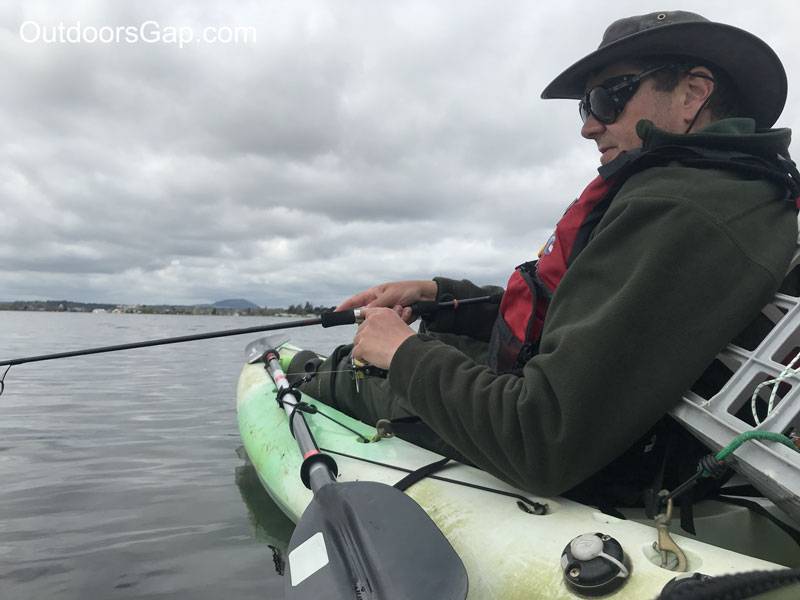
While a baseball cap looks cool, a wide brimmed hat will give you more protection from the sun on the water, especially on the back of the neck and side of the face. (I do wear a baseball hat for filming fishing videos.)
Also if you are fishing clear enough waters, you can combine Polaroid sunglasses and a wide brimmed hat fish to help see the fish easier. This combo also help seeing underwater snags and hazards when paddling.
A wide brimmed hat can also offer protection when you are fly-fishing on windy days from stray flies.
- Have The Landing Net Handy
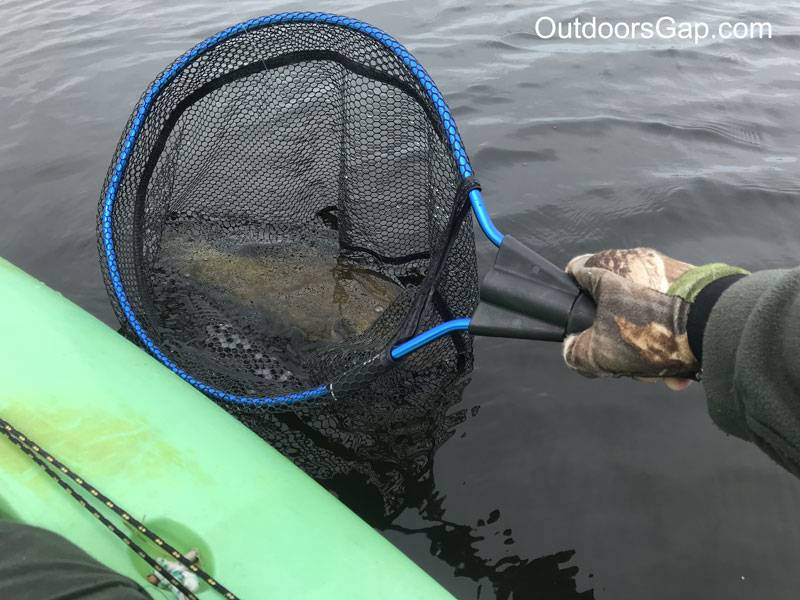
Set up your kayak, so the landing net (or fish lip grips) are close by. Some anglers have it sticking up behind the seat, so it is easy to grab (sort of) while playing a fish.
- Torches / Headlamp
As well as a safety item, a flashlight is handy, even if you don’t plan on fishing at night time. You might get lost on the water, or get onto fish and stay longer than expected in the evening.
A headlamp is great for hands free tying knots and checking gear.
A torch is good for a backup light and flashing approaching boats.
Check your batteries before you head out fishing. Have some spare batteries with you in a dry bag, or at least in the glovebox.
- Use A Comfy Seat
The more comfortable a seat is, the longer you can fish. The longer you can fish, the more potential for catching fish.
I have fished all night and a comfortable seat makes a world of difference on the water.
- Catch And Release
It is good to have a feed of fish, but to remember catch and release is an option. As it can help young anglers catch a fish as well. Or the fish you released now, can grow into a trophy size fish in the future.
- Use A Kayak Trolley
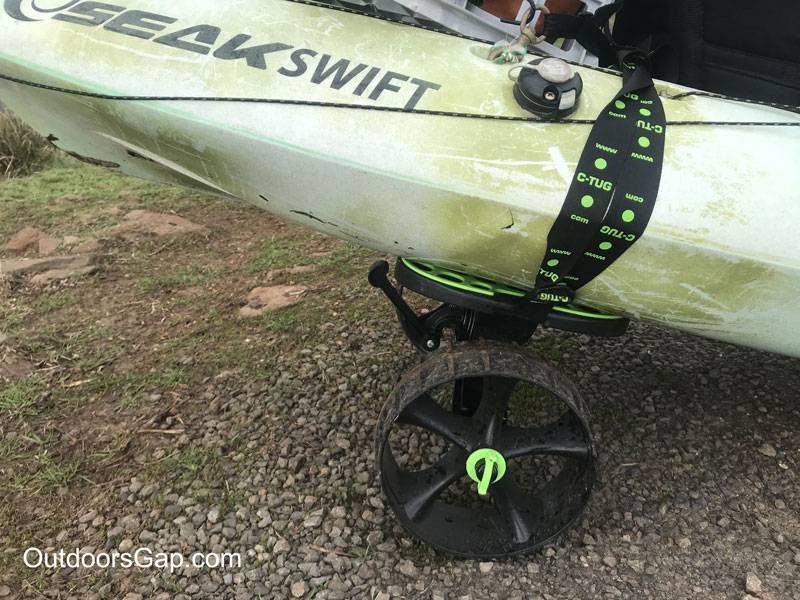
It is no fun trying to lug a heavy fishing kayak and fishing gear a long way, (or even a short way) cross country. So a kayak trolley makes getting to the water’s edge easier.
You might even make your own DIY kayak trolley.
The RailBlaza C-Tug kayak trolley is one of the best around. It has wide wheels for sand and can also be disassembled easily and put in the kayak.
- Kayak Weight Limits
Kayaks and fishing kayaks have a recommended weight range for them. If you go over this range, the kayak will sink lower in the water and be harder to paddle.
When choosing a kayak allow for not only the weight of the angler, but also the fishing gear. Landing net, anchor, fishing rod, tackle box, safety gear, storage tub or milk crate, the weight can all add up. So take this into account when choosing a fishing kayak.
- Pedal Power
The newer pedal kayaks are great for hands free manoeuvring. You can still cast while moving.
While they are not as cheap as the paddle only models, they give you more options when fishing, especially with tides and currents.
- Kayaking Gloves
If you haven’t paddled much, it is easy to get sore hands and blisters, so a pair of fishing or kayaking gloves can help prevent blisters.
A pair of gloves can also stop the back of your hands from getting sunburnt.
For cold water kayak fishing, I use a pair of wetsuit gloves, that I have chopped the index finger glove tip off and thumb, so I can still feel the fishing line and wind easier.
- Minimal Rods
If you are a beginner, just start off with taking one rod out in the kayak. The reason if it is the first time kayaking, you have to paddle (or pedal), balance, steer, anchor, be aware of conditions and other boats hazards, so having extra rods can extra complications and tangles you don’t need.
When you get more experienced you can take out extra rods, but keep it simple for a start.
- Set Your Fishing Kayak Out On Land
Sit in your kayak on land and see if you can access your fishing gear easily.
You should have things you use more often closer to you (like bait, lures, knife or clippers) and should be able to access them without twisting too much and overbalancing the kayak.
Utilize storage hatches, crates and dry bags to hold gear near you.
It may take you a fair few trips before you set out everything on the kayak the way you like it.
Set out your fishing rod holders in places that suit your fishing technique and style.
Fishing rod holders like the Railblaza range, make positioning easier and gives you more options.
For more information, click on – How To Outfit A Kayak For Fishing
- Know The Fish’s Behaviour
Understanding the fish’s behaviour is important so you can present the right bait, lure or fly at the correct depth and action to entice the fish.
For some underwater video of trout and redfin feeding and swimming, watch the Youtube Video below on Trout & Redfin Underwater Footage.
Check out how the fish responds to a Z-man, soft plastic 2.5 inch curly tail grub lure that doesn’t move.
- Relax!
Sometimes we don’t catch a fish and it can be discouraging, but that is fishing. So relax, enjoy being on the water, company and marine life, regardless if we catch fish or not.
Conclusion
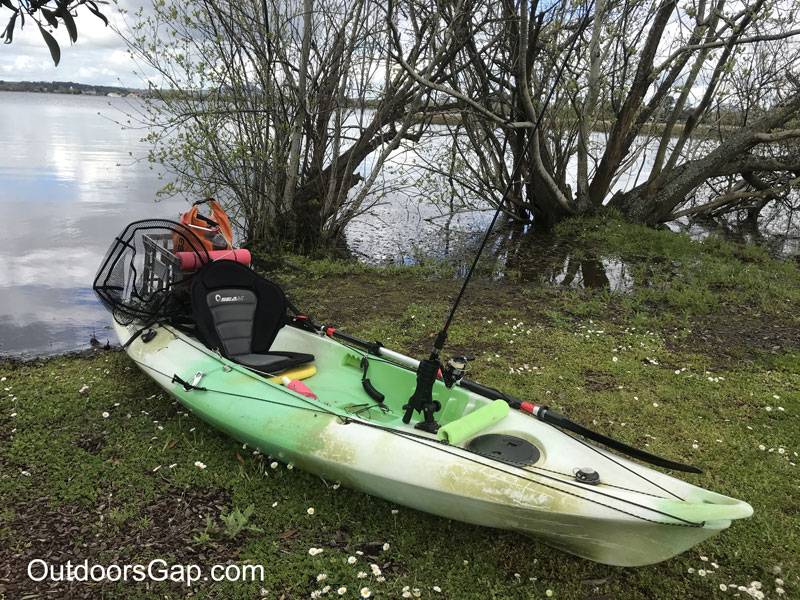
Kayak fishing can be great fun, but with a few simple tips and hints it can be more enjoyable, so we hope you enjoyed these kayak fishing tips for beginners.
Stay safe and remember to wear your life jacket at all times in the kayak and we hope you land a big one.

